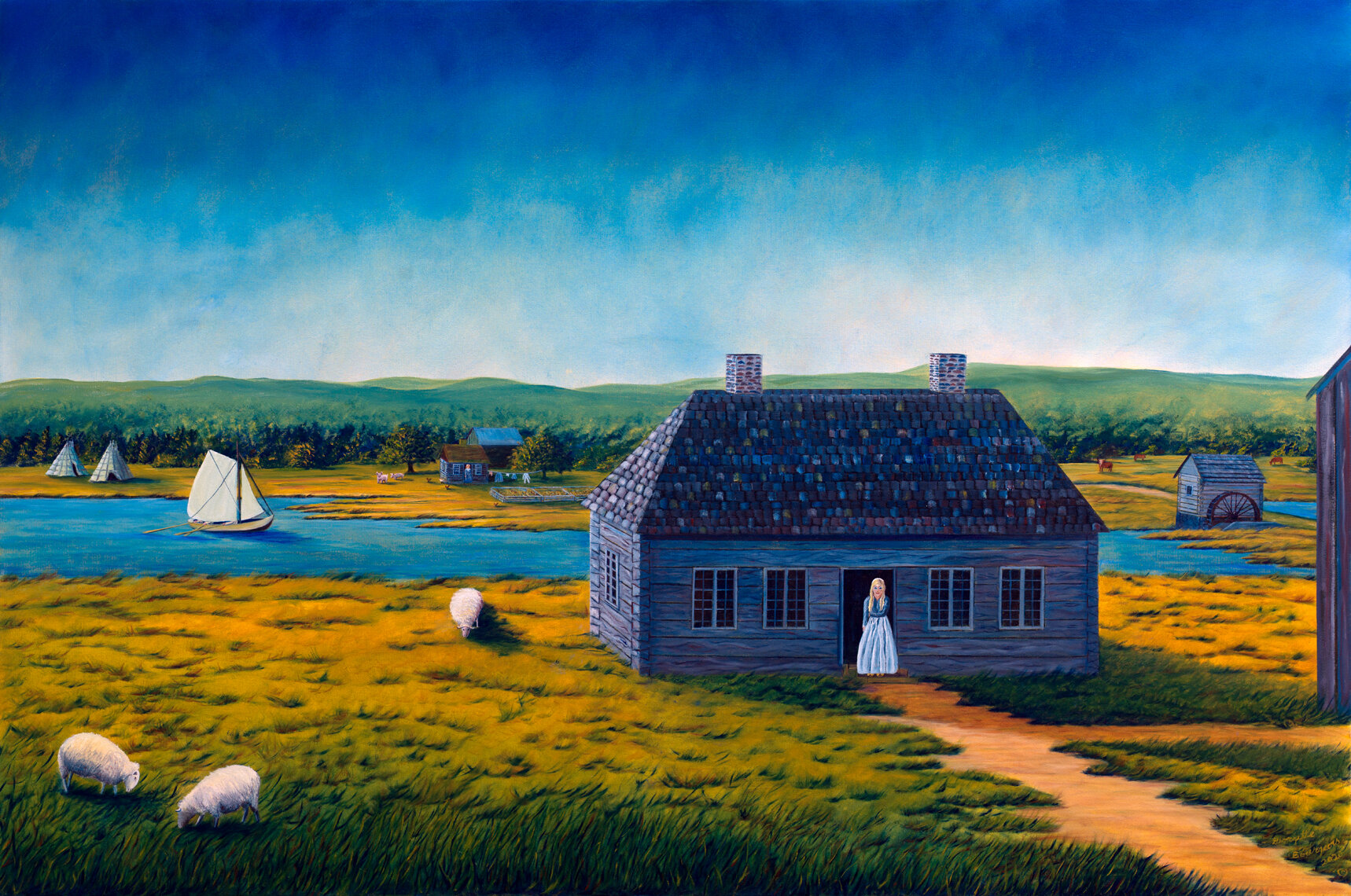Acadian Art: The Tenacity & Influence of the Acadian People by Georgette Bourgeois
This article by Georgette Bourgeois was featured in French in Issue 15: Come From Away. It is offered here in English translation.
For almost two years, I worked on a major project in research and creation, Oeuvres historiques de la Seigneurie de Remsheg, that describes the way of life of Acadians prior to the Deportation of 1755.
My maternal grandparents were visionary builders in Acadia. Both were involved in building the symbolic Acadian cathedral Notre-Dame-de-l’Assomption. My grandmother was a cofounder of the financial institution l’Assomption-Vie. From them, I received a specific education in the history and development of the Acadian people in the Moncton area. My mother, an art teacher and painter and my father, a professional photographer, in turn gave me the tools and the vision to pursue the creation of historical Acadian art.
“Manoir du Seigneur” by Georgette Bourgeois, photo by Denis Duquette
At the heart of my work and visible in my process is the rebuilding of the Acadian people. Oeuvres historiques de la Seigneurie de Remsheg was developed in collaboration with the author Stephen Leahey and his wife Dennice, with the participation of the organization Nation Prospère Acadie. Stephen writes about Acadians living before 1755 on the Northumberland Shore. He sought me out for this project because of my work in the collections of major historic sites, such as Le Pays de la Sagouine, the Grand-Pré National Historic site and le Village Historique Acadien; equally, because of my success in residencies and international projects in Acadia, from France to Louisiana.
The Acadians emigrated from France to the New World in the early 1600s. In their struggle to survive in a new environment, they developed strong ties with the Mi'kmaq people. The two peoples established resilient social, familial, economic and military relationships.
“Moulin à grain” by Georgette Bourgeois, Photo by Denis Duquette
Extensive research and exploration of the way of life in Acadia led me to offer a representation of what might have been. Depicted in these paintings are the wide vistas, the architecture and dress, the implements, tasks and activities then so familiar in our part of the world, as documented in the historical records. These works imagine the Remsheg Seigneury that may have existed on the shores of the Northumberland Strait.
The creative work was partly completed during my 2020 artist residency at the Centre des arts et de la culture de Dieppe (CACD). An enriching experience, I was grateful to receive exciting visitors including the Consul général de France, Johan Schitterer, and the Lieutenant Governor of New Brunswick, the Honorable Brenda Murphy. In March, the COVID-19 pandemic forced me to leave the CACD studio and a partially finished “Le Moulin” along with it. Over the next four months in my home studio, I completed “Le Manoir du Seigneur” before returning to the CACD in June.
The completed paintings were exhibited at the CACD throughout the fall 2020 and early winter 2021. The show included 12 preparatory sketches, 10 panels of historical research and exploration and two progressive series leading to the final paintings. Thanks to funding from the New Brunswick Department of Tourism, Heritage & Culture, it also included video documentation of the research, produced by filmmaker Chris Harrigan. With the show now complete, the historical paintings will become part of the permanent collection of a new gallery to be installed at the Centre de l’Acadie et de la Francophonie de Halifax.
As I worked to create the intense light and huge skies in these paintings, I often had flashes of pride and admiration for the strength, wisdom, and tenacity of my ancestors. My use of intense complementary colours underscores the character and spirit that served them so well in surviving the Grand Dérangement. The early Acadians gave rise to a society that has influenced the fundamental structure of New Brunswick, of Quebec, of the Atlantic provinces, and of Canada itself.
Georgette Bourgeois
www.georgettebourgeois.com
georgettebourgeois2@gmail.com
Written with assistance from writer Monique Arsenault
Research References:
Photos of Kings Landing, New Brunswick
Photos of Village historique Acadien, New Brunswick
Drawings of Port Royal 1686
Drawings of Fort Beauséjour 1755
Drawings of Fort Louisbourg
Illustrations of building structures in France and Europe in the 1600s and 1700s
Photos of the landscape taken during 4 trips in the Pugwash, Nova Scotia
Photos of old building structures in Acadia and in New France (Quebec)



